
In England, the butler's desk, a piece of furniture designed for those in service to fine houses to keep documents and records, was eminently practical and based on the ever-growing needs of an increasingly literate group of persons in service.

In England, the butler's desk, a piece of furniture designed for those in service to fine houses to keep documents and records, was eminently practical and based on the ever-growing needs of an increasingly literate group of persons in service.
While the lord of the house commanded the final say in all matters, the need to delegate certain tasks to the highest ranking servant of the house necessitated a specific location where records could be kept. Following the founding of both Oxford and Cambridge, an increasingly literate aristocracy replaced the largely uneducated peerage. As the power of England grew, so did the wealth of the elite as did the need of the great houses of England to bring in a better informed class of help. This better educated servant class permitted the person so designated to acquire supplies and obtain services to maintain and run large buildings with many servants.
The earliest form of butler's desk was a high desk for use by a standing person. It had many drawers of different size and had locks on both the drop front (which later developed) and individual drawers - the size of the drawers being governed by the size of the documents they contained and for personal use (some of the larger drawers being used for the butlers clothes in order to save space in the head butlers personal room). Many of these desks would have a secret compartment reserved for any important documents that were entrusted to the head butler by the master.
By the 1850s the butler's desk became far more stylistically diffuse. There were many instances where the desk of the lord of the manor was handed down to the head of the house. As the role of the butler became more oriented to a kind of overall manager and coordinator for household functions, the taller earlier desk was abandoned for a more practical piece of furniture.

A desk or bureau is a piece of furniture with a flat table-style work surface used in a school, office, home or the like for academic, professional or domestic activities such as reading, writing, or using equipment such as a computer. Desks often have one or more drawers, compartments, or pigeonholes to store items such as office supplies and papers. Desks are usually made of wood or metal, although materials such as glass are sometimes seen.
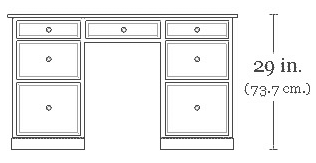
A pedestal desk or a tanker desk is usually a large, flat, free-standing desk made of a simple rectangular working surface resting on two pedestals or small cabinets of stacked drawers of one or two sizes, with plinths around the bases. Often, there is also a central large drawer above the legs and knees of the user. Sometimes, especially in the 19th century and modern examples, a "modesty panel" is placed in front, between the pedestals, to hide the legs and knees of the user from anyone else sitting or standing in front. This variation is sometimes called a "panel desk". The smaller and older pedestal desks with such a panel are sometimes called kneehole desks, they were intended for small spaces like boudoirs and were usually placed against a wall. The kneehole desks are also known as bureau tables.

A secretary desk or escritoire is made of a base of wide drawers topped by a desk with a hinged desktop surface, which is in turn topped by a bookcase usually closed with a pair of doors, often made of glass. The whole is usually a single, tall and heavy piece of furniture.
The portable desk had many forms and is an ancestor of the portable computer, the modern laptop an atavistic grandchild of the 19th-century lap desk.

The Wooton desk is a variation of the fall front desk, native to Indianapolis, Indiana, and produced from 1874 to 1890.

An office is a space where the employees of an organization perform administrative work in order to support and realize the various goals of the organization. The word "office" may also denote a position within an organization with specific duties attached to it ; the latter is an earlier usage, office as place originally referring to the location of one's duty. In the adjective form, the term "office" may refer to business-related tasks. In law, a company or organization has offices in any place where it has an official presence, even if that presence consists of a storage silo, for example, instead of a more traditional establishment with a desk and chair. An office is also an architectural and design phenomenon, including small offices, such as a bench in the corner of a small business or a room in someone's home, entire floors of buildings, and massive buildings dedicated entirely to one company. In modern terms, an office is usually the location where white-collar workers carry out their functions.

The bureau Mazarin is a 17th-century desk form named more or less in memory of Cardinal Mazarin, who was the Chief minister of France from 1642 to 1661. It is the earliest predecessor of the pedestal desk and differs from it by having only two tiers of drawers or three tiers of rather small drawers under the desktop surface, followed by eight legs supporting the whole. Also, the bureau Mazarin has cross braces between the legs, forming two Xs or two Hs on each side.
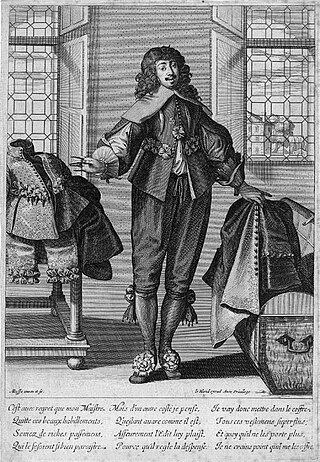
A valet or varlet is a male servant who serves as personal attendant to his employer. In the Middle Ages and Ancien Régime, valet de chambre was a role for junior courtiers and specialists such as artists in a royal court, but the term "valet" by itself most often refers to a normal servant responsible for the clothes and personal belongings of an employer, and making minor arrangements. In the United States, the term most often refers to a parking valet, and the role is often confused with a butler.

A domestic worker is a person who works within a residence and performs a variety of household services for an individual, from providing cleaning and household maintenance, or cooking, laundry and ironing, or care for children and elderly dependents, and other household errands. The term "'domestic service" applies to the equivalent occupational category. In traditional English contexts, such a person was said to be "in service".

A bedroom or bedchamber is a room situated within a residential or accommodation unit characterised by its usage for sleeping. A typical western bedroom contains as bedroom furniture one or two beds, a clothes closet, and bedside table and dressing table, both of which usually contain drawers. Except in bungalows, ranch style homes, ground floor apartments, or one-storey motels, bedrooms are usually on one of the floors of a dwelling that is above ground level. Beds range from a crib for an infant; a single or twin bed for a toddler, child, teenager or single adult; to bigger sizes like a full, double, queen, king or California king). Beds and bedrooms are often devised to create barriers to insects and vermin, especially mosquitoes, and to dampen or contain light or noise to aid sleep and privacy.
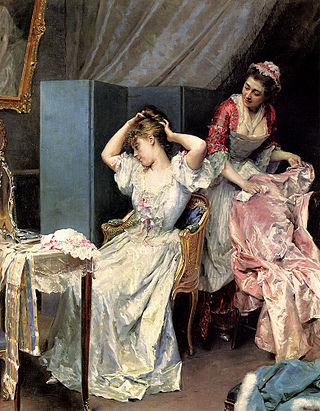
A maid, housemaid, or maidservant is a female domestic worker. In the Victorian era, domestic service was the second-largest category of employment in England and Wales, after agricultural work. In developed Western nations, full-time maids are now typically only found in the wealthiest households. In other parts of the world, maids remain common in urban middle-class households.

A butler is a person who works in a house serving and is a domestic worker in a large household. In great houses, the household is sometimes divided into departments with the butler in charge of the dining room, wine cellar, and pantry. Some also have charge of the entire parlour floor and housekeepers caring for the entire house and its appearance. A butler is usually male and in charge of male servants while a housekeeper is usually a woman and in charge of female servants. Traditionally, male servants were better paid and of higher status than female servants. The butler, as the senior male servant, has the highest servant status. He can also sometimes function as a chauffeur.
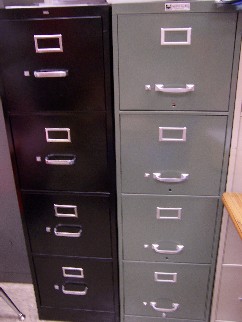
A filing cabinet is a piece of office furniture for storing paper documents in file folders. In the most simple context, it is an enclosure for drawers in which items are stored. The two most common forms of filing cabinets are vertical files and lateral files. A vertical file cabinet has drawers that extend from the short side of the cabinet. A lateral file cabinet has drawers that extend from the long side of the cabinet. These are also called side filers in Great Britain. There are also shelf files which go on shelves. In the United States, file cabinets are usually built to accommodate 8.5 × 11 paper, and in other countries, filing cabinets are often designed to hold other sizes of paper, such as A4 paper.

A table is an item of furniture with a raised flat top and is supported most commonly by 1 to 4 legs. It is used as a surface for working at, eating from or on which to place things. Some common types of tables are the dining room tables, which are used for seated persons to eat meals; the coffee table, which is a low table used in living rooms to display items or serve refreshments; and the bedside table, which is commonly used to place an alarm clock and a lamp. There are also a range of specialized types of tables, such as drafting tables, used for doing architectural drawings, and sewing tables.

A chest of drawers, also called a dresser or a bureau, is a type of cabinet that has multiple parallel, horizontal drawers generally stacked one above another.
Campaign furniture is a type of furniture which is made for travel. Historically, much of it was made for military campaigns.

The still room is a room for preparing household compounds, found in most great houses, castles or large establishments throughout Europe, dating back at least to medieval times. Stillrooms were used to make products as varied as candles, furniture polish, and soap; distillery was only one of the tasks carried out there.
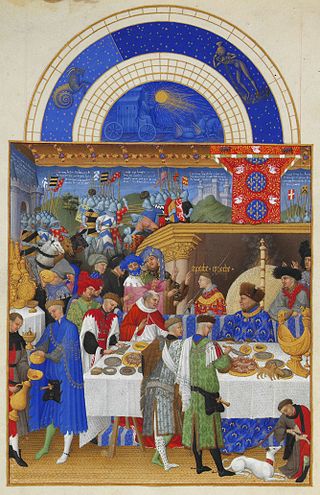
The medieval household was, like modern households, the center of family life for all classes of European society. Yet in contrast to the household of today, it consisted of many more individuals than the nuclear family. From the household of the king to the humblest peasant dwelling, more or less distant relatives and varying numbers of servants and dependents would cohabit with the master of the house and his immediate family. The structure of the medieval household was largely dissolved by the advent of privacy in early modern Europe.

The Hoover desk, also known colloquially as FDR's Oval Office desk, is a large block front desk, used by Presidents Herbert Hoover and Franklin D. Roosevelt in the Oval Office. Created in 1930 as a part of a 17-piece office suite by furniture makers from Grand Rapids, Michigan, the Art Deco desk was given to the White House by the Grand Rapids Furniture Manufacturers Association during the Hoover administration. The desk was designed by J. Stuart Clingman, and was built by the Robert W. Irwin Company from American lumber and faced with Michigan-grown maple burl wood veneer. After Roosevelt's sudden death in 1945, Harry S. Truman removed the desk from the Oval Office and gave it to Roosevelt's wife, Eleanor Roosevelt. She displayed it at, and later donated it to, the Franklin D. Roosevelt Presidential Library and Museum in Hyde Park, New York. The desk has been on display there ever since. The Hoover desk is one of only six desks to be used by a president in the Oval Office.

What later came to be known as the William and Mary style is a furniture design common from 1700 to 1725 in the Netherlands, Kingdom of England, Kingdom of Scotland and Kingdom of Ireland, and later in England's American colonies. It was a transitional style between Mannerist furniture and Queen Anne furniture. Sturdy, emphasizing both straight lines and curves, and featuring elaborate carving and woodturning, the style was one of the first to imitate Asian design elements such as japanning.